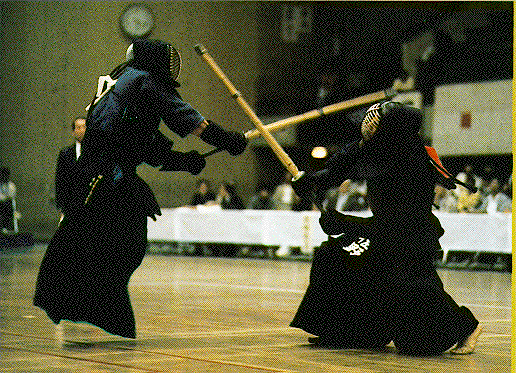1c. What is kumdo?
Kumdo is the Korean pronounciation of kendo. Kendo was introduced to Korea by
the Japanese during the
occupation. After the Japanese left, the Koreans continued practicing using
slightly different gear and new
terminology. A considerable amount of revisionist history can be found
regarding Kumdo which can be attributed
to a strong nationalistic attitude, not to mention bitterness towards the
Japanese.
According to some sources, Korea does have its own style of swordsmanship but
it is little practiced and mostly
lost. The older style seems quite circular and often incorporates kicks and
punches into the forms: it seems
related to Kumdo only in that a sword is used. During the 15th century
Japanese swords were imported in
significant numbers; previously Korean swords had been straight and mostly
double-edged. Most of the older
texts which survive label the weapons used as "Japanese swords" but may have
been showing older forms
incorporating the more modern weapon.
1d. Are there different styles of kendo/kenjutsu?
Kendo is pretty much the same world-wide. Most dojos are governed by the
International Kendo Federation
(IKF), which grew from the Zen-Nippon Kendo Renmei (ZNKR, the All-Japan Kendo
Federation). There is a
second federation in Japan, not as popular, but the differences are more
political than technical.
There used to be hundreds of kenjutsu ryu; only two dozen or so have survived
and they are mostly very small
organizations. One of the oldest is Tenshin Shoden Katori Shinto Ryu. There
is also Itto Ryu, from which much of
modern kendo is derived. Here is a list of known surviving ryu compiled by
Antony Karasulas and Satoshi
Yokota:
- Abe Ryu
- Yagyu Shinkage Ryu
- Niten Ichi Ryu
- Mugai Ryu
- Jigen Ryu
- Muso Jikiden Eishin Ryu
- Omori Ryu
- Katori Shinto Ryu
- Kashima Shinto Ryu
- Suio Ryu
- Muso Shinden Ryu
- Maniwa Nen Ryu
- Takenouchi Ryu
- Yagyu Shingan Ryu
- Tatsumi Ryu
- Shinkage Ryu
- Muraku Ryu
- Jikishinkage Ryu
- Hoki Ryu
- Ono-ha Itto Ryu
- Hokushin Ryu
- Nakanishi-ha Itto Ryu
- Tamiya Ryu
- Shindo Munen Ryu
- Itto Ryu


kjartan@ii.uib.no
 Kendoka wear armour protecting the head, throat, wrists and abdomen;
these are the only legal targets. The split-bamboo practice sword, called
a shinai, is wielded two-handed; the kendoka faces his opponent
squarely. A small number of high-level practitioners utilize a shinai in
each hand. Kendoka move using a peculiar gliding step refined for use
on the smooth floors of the dojo. Kendoka generally practice as
partners although the basics of posture, movement, grip and swing are
learned in supervised solo practice. Because of the equipment, kendoka
can and do practice full speed and full power, including free-sparring.
Kendoka sometimes practice partner kata similar to kenjutsu, in which
two partners carry out a prescribed series of attacks with wooden or
steel swords.
Kendoka wear armour protecting the head, throat, wrists and abdomen;
these are the only legal targets. The split-bamboo practice sword, called
a shinai, is wielded two-handed; the kendoka faces his opponent
squarely. A small number of high-level practitioners utilize a shinai in
each hand. Kendoka move using a peculiar gliding step refined for use
on the smooth floors of the dojo. Kendoka generally practice as
partners although the basics of posture, movement, grip and swing are
learned in supervised solo practice. Because of the equipment, kendoka
can and do practice full speed and full power, including free-sparring.
Kendoka sometimes practice partner kata similar to kenjutsu, in which
two partners carry out a prescribed series of attacks with wooden or
steel swords. Kendo is the way of the sword, Japanese fencing. About 8 million
people worldwide participate, 7 million of them in Japan. It is taught as
part of the school physical education curriculum. College kendo teams
in Japan are high-profile; major competitions are televised complete with
colour commentary.
Kendo is the way of the sword, Japanese fencing. About 8 million
people worldwide participate, 7 million of them in Japan. It is taught as
part of the school physical education curriculum. College kendo teams
in Japan are high-profile; major competitions are televised complete with
colour commentary.  Yes, with qualifications. Not every aikido dojo offers qualified
instruction in actual sword techniques. Many of them use bokken
practice only as a way of better understanding the empty-handed
techniques, as these techniques are grounded in kenjutsu.
Yes, with qualifications. Not every aikido dojo offers qualified
instruction in actual sword techniques. Many of them use bokken
practice only as a way of better understanding the empty-handed
techniques, as these techniques are grounded in kenjutsu.

